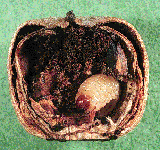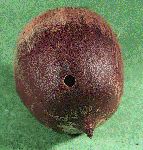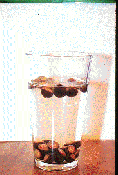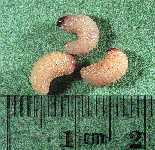
University of Kentucky Department of Entomology







Entfact 804Acorns for RentBy
Lana Unger,
|
 | The young acorn weevil larvae hatch inside the acorn after one or two weeks. The larvae develop inside the acorn, feeding on the nutmeat for about 3 weeks. The more larvae inside an acorn, the slower they develop because they must share the available food. |
The infested acorn falls from the tree about the time that the weevil larvae are fully grown. When the acorn hits the ground, it is a signal to the acorn weevil larvae that it is time to chew their way out. This process can take from 2 hours to 3 days, depending on the thickness of the acorn shell. Once the acorn weevil larva breaks free of the acorn, it tunnels down into the ground and makes an earthen cell in which to spend the winter. The larva will stay in its winter home for up to 5 years before it emerges one summer as an adult acorn weevil.
 | The empty acorn can be used by other insects for food and shelter. A different insect, the acorn moth, may lay an egg near the exit hole left by the acorn weevil larva. After the egg hatches, the acorn moth catepillar climbs through the hole into the acorn, where it spends the winter. The following spring it leaves the acorn before turning into an acorn moth. |
Acorn moth larvae are not the only insects that use the vacated acorns. Other residents such as fruit flies and fungus gnats can move into the decaying acorns.
ACTIVITY
Things you will need:
- bucket filled with water
- nut cracker (or a small hammer)
- magnifying glass
| Find a nearby oak tree. Beneath the tree, you will find acorns that have fallen to the ground. Collect several dozen acorns and place them in the bucket of water. Uninfested acorns will sink to the bottom of the bucket, but if insects have hollowed out the acorns, they will float. |  |
Remove the floating acorns from the water. Use the nutcracker (or hammer) to open some of the acorns. Inside, you may find different types of insects.
 | For example there might be acorn weevil larvae (grubs) or small moth larvae (caterpillars). The inside of the inhabited acorns are usually dark brown and mealy. The insects use the nutmeat as food and it will look more like dirt than nutmeat. |
ADDITIONAL ACTIVITIES
- Draw a picture of an acorn weevil larvae and its acorn home.
- Place some uncracked acorns, (the ones that floated), on a moist towel, in a wide mouthed jar or other clear container. Make sure that the towel stays moist. Cover the container with cheesecloth to prevent the emerging insects from escaping. Wait and see what emerges from the acorns. Make sure you look at the bottom of the container under the towel because many insects, including acorn larvae, will try to tunnel into the ground as soon as they leave the acorns.
- Compare infestation rates over a period of time. Collect 50 acorns every two weeks (during October and November) for a total of three or more collection times and determine the percent of infested nuts for each sample collected. After each collection time, crack open all of the acorns that you collected. Count the number of acorns that have one or more acorn larvae inside. Divide this number by 50 (the total number of acorns collected) to get the percent of infested nuts. Make a graph showing the change in infestation rate against time. Is the weevil population increasing or decreasing?
- Collect acorns from several different trees. Notice that acorns come in many shapes and sizes. Try to predict the sizes and numbers of insects in the different acorns. Then crack them open to see if your predictions were correct.
- Discuss effects that the acorn weevils
could have on the oak tree. Are the weevils
beneficial insects, pests or both? How do they fit
into a food chain?
Insects All Year cartoon courtesy of C. Ware, copyright 1998
Last updated: 21 January 1999
 Return to UK Department of Entomology Katerpillars page
Return to UK Department of Entomology Katerpillars page Return to UK Department of Entomology homepage
Return to UK Department of Entomology homepage Return to University of Kentucky homepage
Return to University of Kentucky homepage